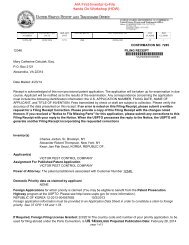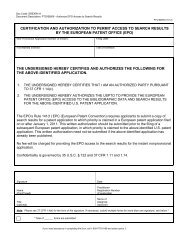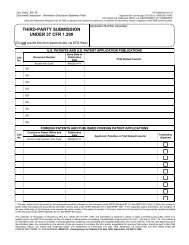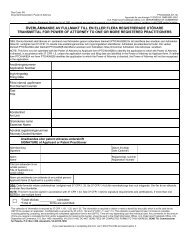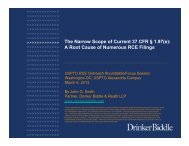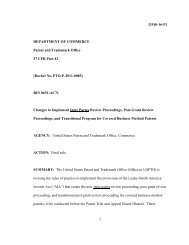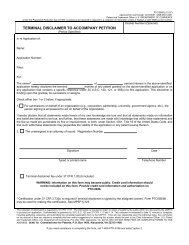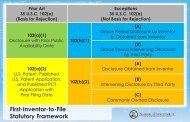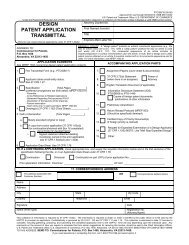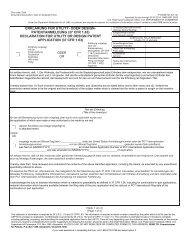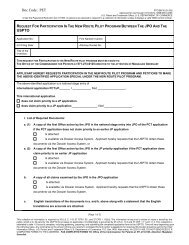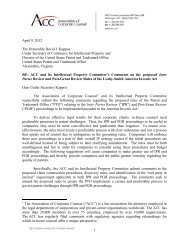USPTO Performance and Accountability Report - U.S. Patent and ...
USPTO Performance and Accountability Report - U.S. Patent and ...
USPTO Performance and Accountability Report - U.S. Patent and ...
Create successful ePaper yourself
Turn your PDF publications into a flip-book with our unique Google optimized e-Paper software.
On the basis of the <strong>USPTO</strong>’s comprehensive<br />
internal control program during<br />
FY 2012, the <strong>USPTO</strong> can provide<br />
reasonable assurance that its internal control<br />
over the effectiveness <strong>and</strong> efficiency of operations<br />
<strong>and</strong> compliance with applicable laws<br />
<strong>and</strong> regulations as of September 30, 2012, was<br />
operating effectively. Accordingly, I am pleased<br />
to certify with reasonable assurance that our<br />
agency’s systems of internal control, taken as a<br />
whole, comply with Section 2 of the Federal<br />
Managers’ Financial Integrity Act of 1982.<br />
Our agency also is in substantial compliance<br />
with applicable federal accounting st<strong>and</strong>ards<br />
<strong>and</strong> the U.S. St<strong>and</strong>ard General Ledger at the<br />
transaction level <strong>and</strong> with federal financial<br />
system requirements. Accordingly, our agency<br />
fully complies with Section 4 of the Federal<br />
Managers’ Financial Integrity Act of 1982, with<br />
no material non-conformances.<br />
In addition, the <strong>USPTO</strong> conducted its assessment<br />
of the effectiveness of our agency’s<br />
internal control over financial reporting, which<br />
includes safeguarding of assets <strong>and</strong> compliance<br />
with applicable laws <strong>and</strong> regulations, in<br />
accordance with OMB Circular A-123, Management’s<br />
Responsibility for Internal Control. Based<br />
on the results of this evaluation, the <strong>USPTO</strong><br />
provides reasonable assurance that its internal<br />
control over financial reporting as of June 30,<br />
2012 was operating effectively <strong>and</strong> no material<br />
weaknesses were found in the design or<br />
operation of the internal control over financial<br />
reporting. In addition, no material weaknesses<br />
related to internal control over financial<br />
reporting were identified between July 1, 2012<br />
<strong>and</strong> September 30, 2012.<br />
David J. Kappos<br />
Under Secretary of Commerce for Intellectual<br />
Property <strong>and</strong> Director of the United States<br />
<strong>Patent</strong> <strong>and</strong> Trademark Office<br />
November 7, 2012<br />
MANAGEMENT’S DISCUSSION AND ANALYSIS<br />
effective internal control, <strong>and</strong> comply with legal <strong>and</strong><br />
regulatory requirements. The <strong>USPTO</strong> complied<br />
substantially with the FFMIA for FY 2012.<br />
Other Compliance with Laws<br />
<strong>and</strong> Regulations<br />
Federal Information Security Management Act<br />
The <strong>USPTO</strong> continues to stay vigilant in reviewing<br />
administrative controls over information systems <strong>and</strong><br />
is always seeking methods of improving our security<br />
program. During FY 2012, the <strong>USPTO</strong> continued its<br />
dedicated efforts in support of compliance with<br />
FISMA st<strong>and</strong>ards <strong>and</strong> improvement of our security<br />
program. The <strong>USPTO</strong> IT Security Program includes a<br />
strategy for continuous monitoring, which conducts<br />
credentialed compliance <strong>and</strong> vulnerability scans<br />
on servers, network devices, database, <strong>and</strong> Web-application<br />
on a quarterly basis. The analysis is being<br />
performed to ensure that operating systems have<br />
been configured in accordance with their security<br />
baseline <strong>and</strong> appropriate software patch levels.<br />
Additionally, the IT Security program has integrated<br />
artifacts to support Security Impact Analysis within<br />
the systems development lifecycle that allow assessment<br />
of testing requirements for systems undergoing<br />
new developments, enhancements, or maintenance.<br />
This proactive approach to security within<br />
the development process has successfully assessed<br />
changes <strong>and</strong> enabled security compliance for<br />
systems as they are being developed or updated.<br />
As a result, the Chief Information Security Officer<br />
<strong>and</strong> the OCIO staff working together made a<br />
concerted effort to meet the compliance requirements<br />
of FISMA, while also meeting the reporting<br />
requirements to OMB. These endeavors were a<br />
complete success. All <strong>USPTO</strong> systems achieved a<br />
100 percent FISMA compliance reporting level for<br />
FY 2012. There were no deficiencies identified that<br />
are considered to be the result of any material weaknesses<br />
in internal control. As a result of the work<br />
accomplished, the <strong>USPTO</strong> was able to continue with<br />
continuous monitoring <strong>and</strong> provide an accurate<br />
summary of information consistent with OMB<br />
reporting requirements for year-end reporting.<br />
www.uspto.gov<br />
63


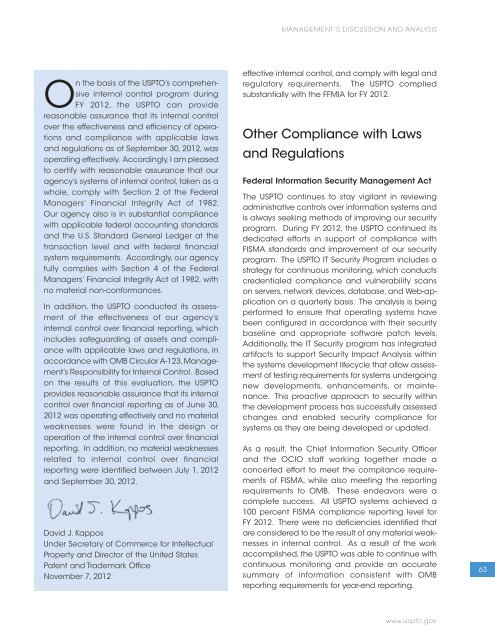
![Printable version [PDF] - United States Patent and Trademark Office](https://img.yumpu.com/51835259/1/184x260/printable-version-pdf-united-states-patent-and-trademark-office.jpg?quality=85)
